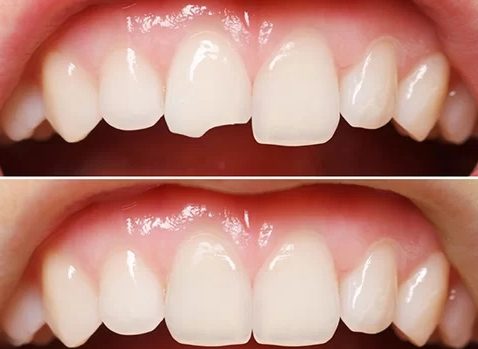
Tooth restoration in different ways
What is tooth restoration?
We said that tooth restoration is a process that a doctor uses a variety of methods to repair teeth, repair rotten teeth, cosmetic restoration of front teeth, repair broken teeth and.. Tooth restoration methods can be divided into two general categories: direct and indirect.

1. Direct tooth restoration methods
Now that we know what tooth restoration is, let’s take a closer look. In a variety of direct dental restorations, work related to repairing decayed teeth or repairing broken teeth is done inside the mouth. This process is called filling, and involves placing a soft substance inside the tooth cavity. This material is then strengthened, so that it can repair the structure of the damaged tooth and sometimes improve its appearance (for example, in the restoration of the beauty of the front tooth).
Direct methods in all types of dental restorations are usually very cost-effective and solve the problem with the least amount of invasion. In various methods of tooth restoration, 3 types of raw materials are used directly:
1-1. Repair decayed teeth with amalgam
Silver amalgam is an alloy of mercury, silver, tin, zinc and copper. Among the advantages of amalgam for the restoration of decayed teeth (even the restoration of front teeth) are its low price, easy placement in the tooth, and its very high strength. However, its use in cosmetic restoration methods is not a good option for repairing decayed front teeth and cosmetic restoration of front teeth. Also, it is possible for it to get bigger or smaller inside the tooth, which can cause cracking and eventually decay.
1-2. Restoration of front teeth with composite
Composite dentures are one of the most popular options in a variety of dental restoration methods (especially cosmetic restorations of the front teeth). These materials are made of composite resins and can have the same color as the color of your main teeth. However, repairing decayed teeth with composite is more expensive than silver amalgam and less durable. On average, you have to replace composite dentures every 5 years.
1-3. Tooth restoration with inomer prosthesis
Inomer glass prosthesis is a strong and creamy combination that is usually used to repair decayed or broken teeth in children and teeth that are not used for biting food. The use of this material in a variety of dental restorations has a relatively balanced price. It also does not change position, does not shrink, and contains fluoride, which prevents tooth decay.
۲. Types of indirect tooth restoration
The steps of various dental restoration methods are performed indirectly, including making raw materials (veneers, crowns, bridges and implants), outside the mouth. Some people believe that different types of dental restorations with dentures are a kind of indirect restoration. However, this term refers to permanent or semi-permanent repairs in dental restorations that cannot be removed.
There are several types of indirect dental restorations; Including examination, preparation of teeth, making temporary materials and veneers, and veneers. As a result, its cost is higher than other types of direct dental restorations. But these methods are a long-term and suitable solution for repairing decayed front teeth, repairing broken teeth, cosmetic repair of front teeth and.. Here are some common types of indirect tooth restoration:
2-1. Tooth crown
Dental veneers or dental caps completely cover the tooth surface. The veneer is prepared on a pre-prepared surface and placed on the tooth with the help of a special glue. Dental veneers improve the strength and appearance of damaged teeth and can be made of metal, ceramic, or a combination of metal and ceramic.
2-2. Tooth bonding
Indirect dental bonding, or veneers, are thin layers of porcelain that can replace or peel off damaged, stained, or improperly shaped enamel. These veneers are designed and produced according to the shape and color of the individual’s main teeth. This method is very popular for repairing broken teeth and repairing front teeth, because its color is very similar to the natural enamel of a person.
2-3. Dental Bridge
In addition to bonding and veneers, dental bridges are also used to repair teeth. Dental bridges are artificial teeth that are placed between the main teeth to fill the space between them (where the tooth is pulled). Dental bridges are usually made of porcelain, metal, or a combination of the two.
2-4. Dental implants
The implant is surgically attached to the jawbone, and is used to hold a dental veneer or bridge. Among all types of dental restorations, the implant restoration process is long and may take up to 6 months. The reason is the formation of new bone around the implant to hold it well.
Does tooth restoration hurt?
What is the most important question after tooth restoration and the types of tooth restoration is whether the tooth restoration is painful or not. This question depends on the severity of the tooth problem (from cracks and fractures to deep caries). But in general, the answer to the question of whether tooth restoration hurts is no. Because all steps are performed under local anesthesia. However, it is normal to feel mild pain or tenderness for up to 2 days after a variety of tooth restoration and tooth decay procedures or broken teeth.



